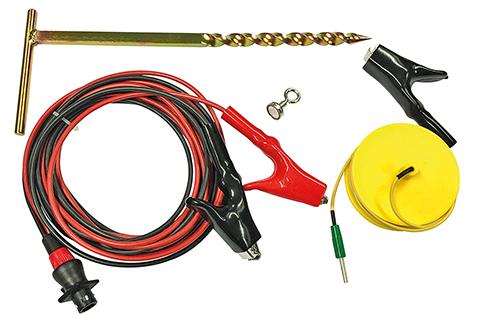The Grounding Rule – Part 2

Grounding Rules, All locators need to strive to achieve a “Good” current on the target line – by good current I mean that the readings on the receiver need to be steady with zero or minimal fluctuation. This then allows you to commence locating; if you do not have good current then changes need to be made to the transmitter setup to improve current levels.
There are 5 things that can be done to improve the level of current on our target line, we call these 4 changes and a move, which is a slight change from Bill Mixer’s saying of 3 changes and a move. In this article we will focus on just one of the elements of these 5 things – that is “Change the Earth” and we will focus even more specifically on the near end earth – this is the one at the transmitters end.
At the near end, e.g. at the transmitter we have the ability to easily move the position of the Earth Stake and therefor alter the path that the return signal takes to return to the transmitter. Remember that one of the Laws of locating (a Law in this context is something that cannot be changed) is that the amount of current that leaves the transmitter MUST return to the transmitter. This is one of Kirchhoff’s Laws, and remember that current will always follow the path of least resistance.
As Locators we can use this knowledge and the positioning of the earth stake for the return current, to our advantage. Let me elaborate.
Consider the scenario below, we have a steel water main, and we have access to the main at the valve, so we can apply a conductive connection to the utility. We want to locate the main to the lateral and then locate the lateral – in other words towards Point 1. The question that we have is where is the best position to set our transmitter and earth stake to achieve the result that we want.
If we position our transmitter and earth stake at position A, the most likely outcome would be:
· The majority of the signal would travel towards point 2.
· A lesser amount travels towards point 3.
· Whilst a minimal amount of the signal would travel towards point 3.
· Red arrows.
(The above assumptions are made assuming that the far end earths at each location is the same.)

However, if we now move the transmitter and the earth stake to position B the following would be the most likely outcome:
The current would once again split along the main, with the majority this time travelling towards the left of the connection point. Once the current reaches the lateral the current would once again split, however this time the majority of the current would travel along the lateral. This occurs because the path of least resistance back to the transmitter is the earth stake that is positioned along the lateral.
The moral to the story is to always allow the earth to work to your advantage.
Have a look at the scenario below:
A. If you placed the earth stake at position A – you would be crossing other buried utilities and if these utilities are metallic, you would run the very real risk of your signal bleeding onto them and thus creating distortion on your target line.
B. If you were to choose position B, the chances are that the return signal would use the centre utility as its path of least resistance for the return signal back to the transmitter.
C. The possibility of creating bleed off and/or distortion on your target line are greatly reduced by positioning the transmitter and earth stake on this side of the underground utilities. The chance of the return signal using one of the other buried utilities back to the transmitter are greatly reduced.

A lot of people commented that by placing the earth stake as far away from the target line as possible you will be able to locate a greater distance – this is 100% correct. BUT if doing this creates difficult situations because of the increased possibility of distorted signals, perhaps it is not the best solution.
Locating Unlimited Pty Ltd (RTO ID 45518), Australasia’s leading provider of Underground Damage Prevention Training is committed to providing training and information to help maintain safe work practices around buried utilities and prevent damage to this infrastructure.
Contact Jeff at Locating Unlimited – 0419 44 66 27 or jeff.moore@locatingunlimited.com.au